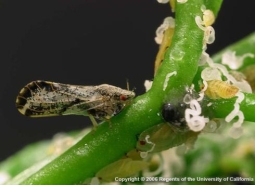University of Florida research Jude Grosser has been working with a new breeding technique that creates tetraploid rootstocks that are showing significantly improved resistance to Huanglongbing. This is done with conventional breeding and is not based on genetic engineering. He takes citrus rootstocks that have shown some resistance but because of their genetic makeup, it has not be possible to interbreed them. This new technique permits these crosses that were before not possible. He and his group have created new rootstocks that are now being field trialed.
http://ashs.org/abstracts/2013/abstracts13/abstract_id_14201.html
Also on another front, Richard Lee and Manjunath Keremane at the USDA Citrus Germplasm Repository in Riverside have been working with University of Hawaii and a private company – Diagenetix – to develop a field test for identifying HLB infected psyllids. LAMP (loo-mediated isothermal amplification) is a faster, cheaper method than the traditional PCR (polymerase chain reaction) method. It would allow for rapid identification of infected psyllids and a more rapid identification of a potential quarantine area. Conventional PCR would still need to be performed to legally identify infected insects. The technology has been used on other disease organisms such as powdery mildew in grape and bacterial infections in stone fruit trees. Literally anything that carries DNA can be identified by this new technique.
http://www.agnet.org/htmlarea_file/library/20110706164834/ac2007k.pdf
Attached Images:
